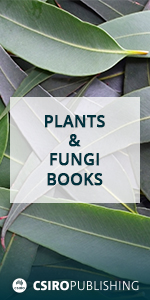Australian Journal of Botany
Volume 69
Number 8 2021
As some remnants of the Brazilian Atlantic rainforest are affected by acid precipitation, knowing the responses of native species might be crucial for identifying the degree of injury to its ecosystems. We analysed the effects of acid rain in a native legume and found widespread necrosis-like dark spots that manifested on the stem. The dark spots are a promising marker for biomonitoring programs in the Atlantic rainforest .
In savannas, bark traits related to disturbance (e.g. herbivory, drought, and fire) play an essential role in plant survival. In this study, we provide descriptions of bark of Melastomataceae species with different habits occupying different sites in the Brazilian Cerrado (a neotropical savanna), from well-drained to temporarily or permanently waterlogged soils. This work demonstrates that bark characteristics do not seem to correspond to plants habits and distribution, except for one species that inhabits waterlogged soils. The characteristics of the bark are useful to distinguish the species.
Plants within the genus Gastrolobium produce poisonous fluoroacetate as a chemical defence against grazing animals. Species within this genus have the tendency to accumulate large amounts of fluoroacetate when growing in soils with low fluoride status. It is unknown whether Gastrolobium species can respond to higher soil fluoride concentrations. The results showed that Gastrolobium can accumulate extremely high fluoride in their leaves with the highest concentrations in young leaves in the highest treatment level. This finding suggests the potential of Gastrolobium species to be used in fluoride phytoremediation of contaminated soils.
In response to environmental disturbances, Cerrado species show different regeneration strategies that are related to their belowground organs. We studied three Eugenia species during resprouting in a Cerrado after the removal and burning of pine trees from a long-term cultivated plantation. Their bud-bearing belowground organs were highly lignified, and contained carbohydrates and protective compounds. The understanding of these functional traits related to the rapid recovery of plants after disturbances contributes to the knowledge of resprouting strategies and can support management actions.
To better understand how soil waterlogging limits tree colonisation in tropical wet grasslands, we investigated seed germination responses to waterlogging in 11 tree species from the Brazilian savannas (Cerrado). Waterlogging reduced or inhibited germination and seedling development in 10 of the 11 study species. In general, tree species from flooded environments had more waterlogging-resistant seeds than those species from non-flooded environments. This study highlights the importance of soil waterlogging as an environmental filter preventing tree colonisation in tropical wet grasslands.
We tested drought sensitivity in reseeder and resprouter seedlings of E. coccinea, a species that contains both reseeder and resprouter morphs. Contrary to expectations, seeder seedlings were more drought sensitive than were resprouter seedlings. Our results challenge the drought-distribution hypothesis for Erica in the Cape Floristic region.
This is the first study to gather and assess geographically broad empirical data on the nutrition of Murray–Darling Basin riverine eucalypts and their soil chemistries. Three key species, Eucalyptus largiflorens, E. camaldulensis, and E. coolabah were found to vary considerably in their ability to accumulate foliage salt. Such data may ultimately prove useful for monitoring tree stress and groundwater salinity, while informing environmental water allocation strategies for tree health.
Floral nectar is a primary driver of pollination. Storage of nectar between collection and analysis can greatly affect sugar characteristics. We aimed to develop an effective method to store nectar on filter paper. Nectar is best eluted with large volumes of water from small filter papers stored with desiccant. Nectar storage methods have rarely been considered as sources of inaccuracy; however, we have demonstrated that prompt analysis is necessary for the most reliable results.
Two successive fires, 3 years apart, were used to remove the dense grass canopy at a degraded former Cumberland Plain Woodland site. The two fires did not result in new native species appearing; nor did species composition move towards that of remnant woodland. The two fires allowed more native species to be present in above-ground vegetation than on unburnt plots, and encouraged growth of native grasses.
The dynamics of a pond and mosaic bolster heath complex monitored for 35 years conformed to a posited cyclic pattern of organic dam growth, organic dam draining, dam dissolution and recolonisation of the dam floor. The stable mosaic bolster heaths between the ponds constantly changed patterns of species distribution while maintaining the same proportionate cover of individual species, a phenomenon most consistent with the stochastics of neutral theory.
How leaves are presented affects interaction of atmospheric CO2, energy (light), and plant physiology. Not much attention has been paid to possible changes in leaf orientation and distribution with elevated CO2, but its effect on plant growth could alter the proportions of sunlit and shaded leaf areas and feedback on carbohydrate available for further growth. We report on first measurements of leaf inclination angle distribution and foliage clumping in a native evergreen Eucalyptus woodland in ambient CO2 and under +150 ppm elevated CO2.
















